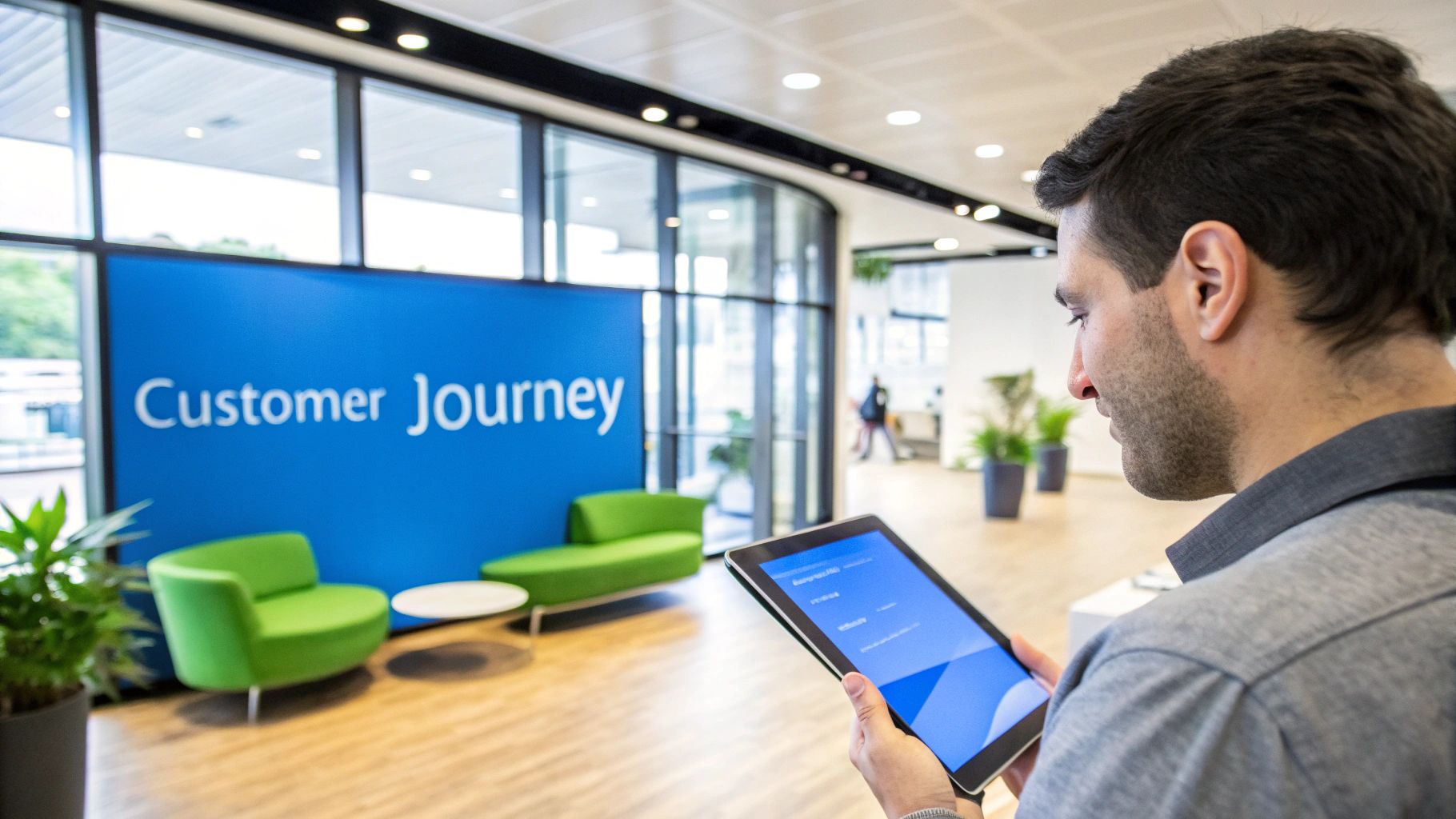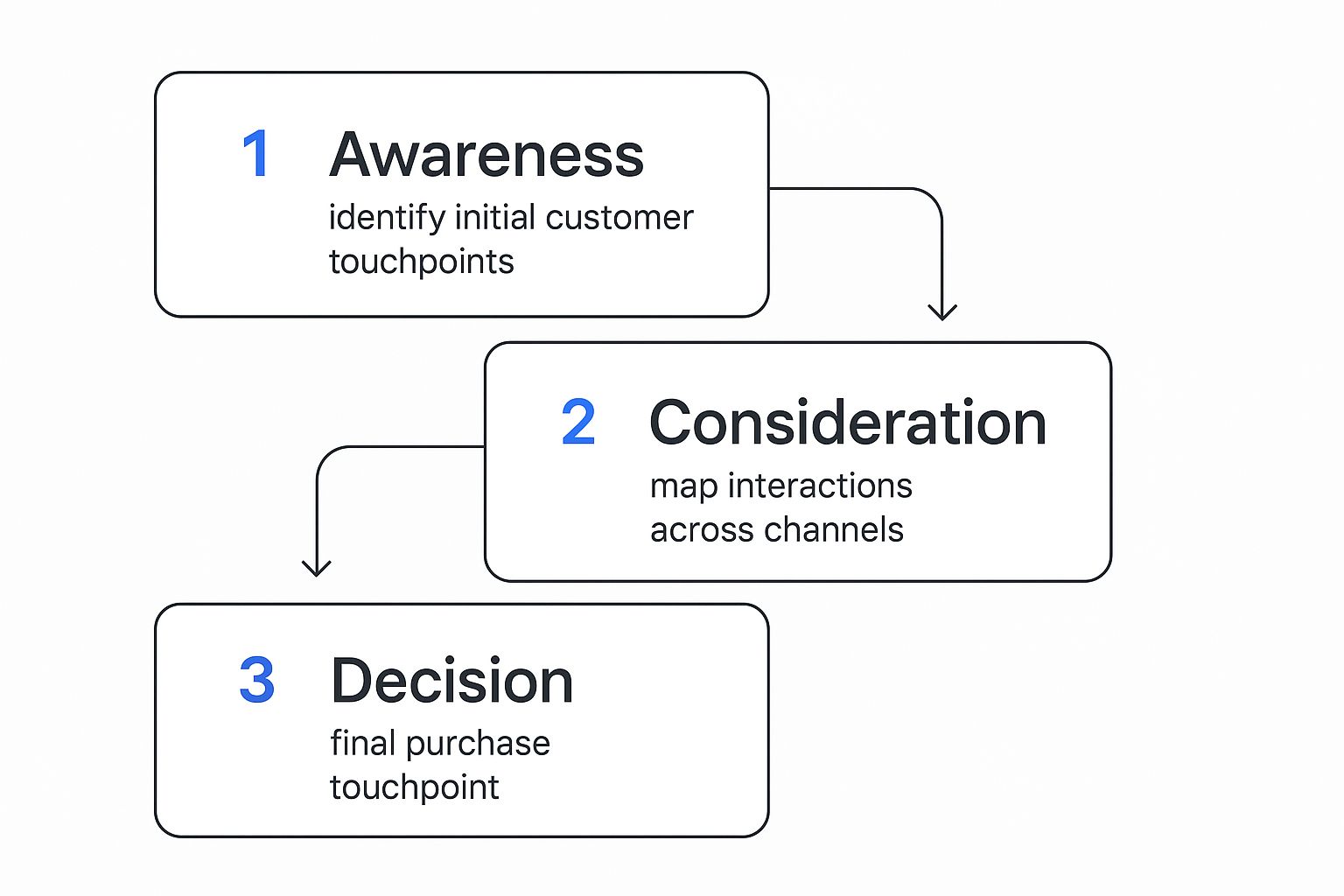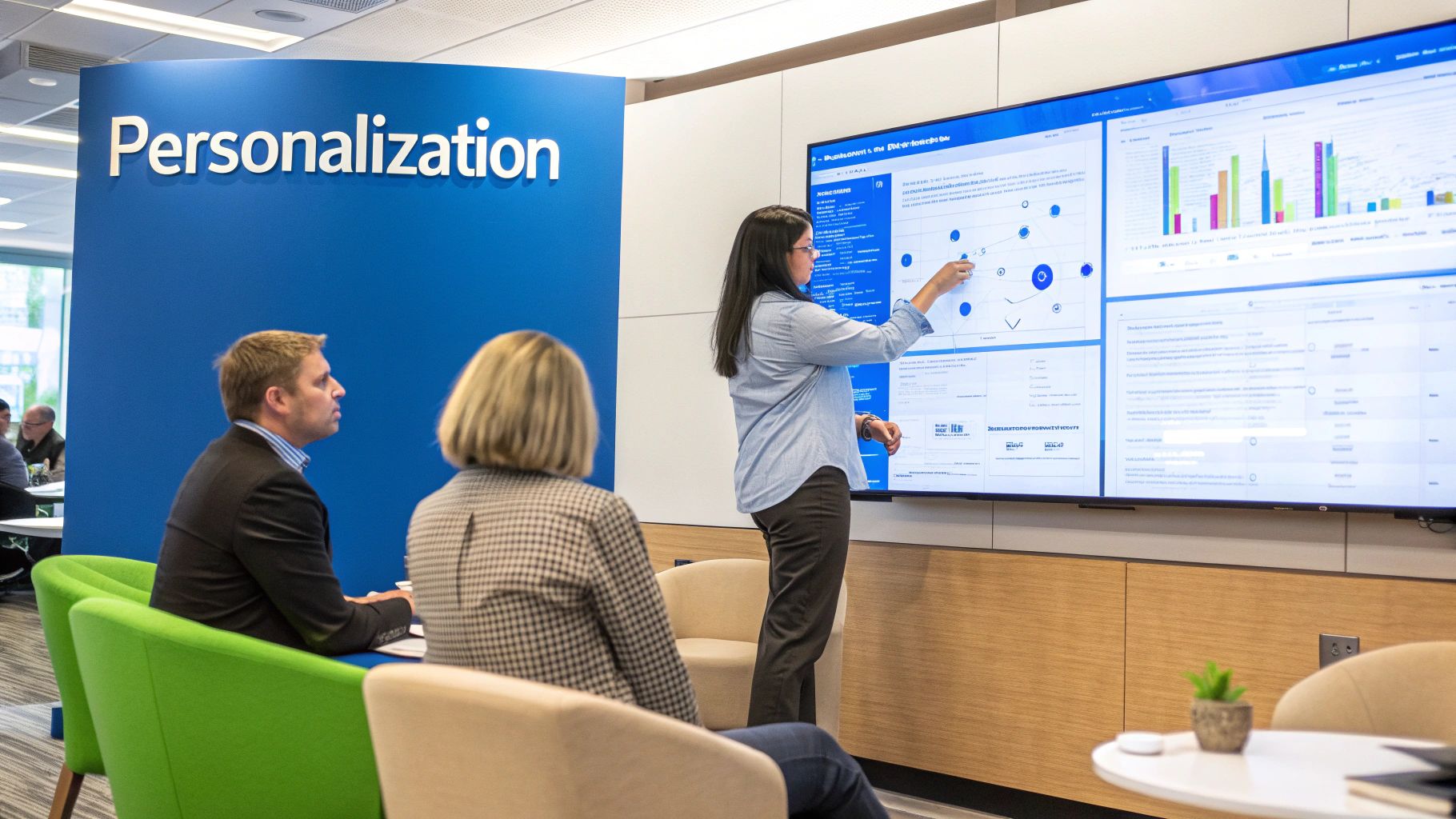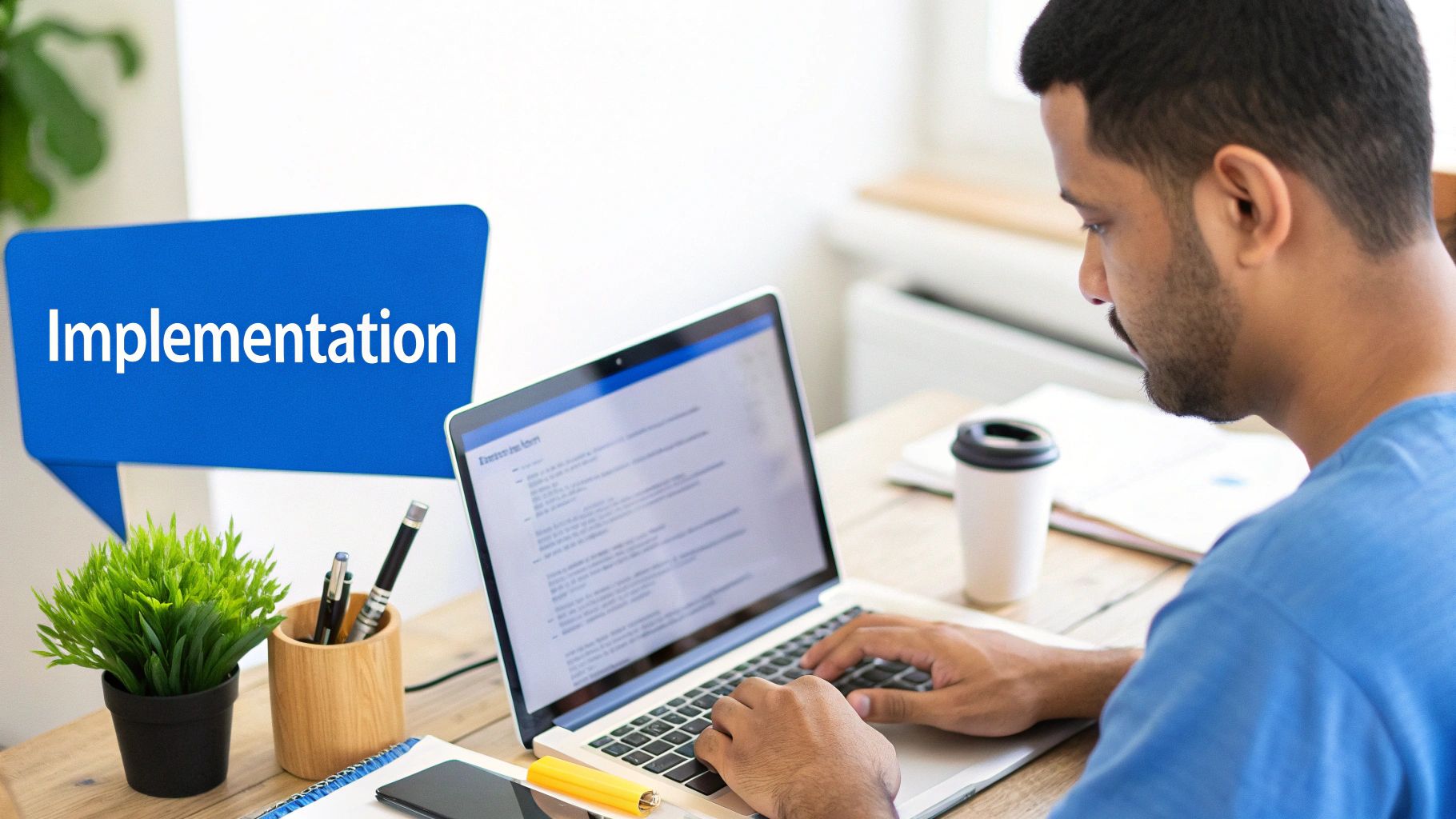Customer journey optimization is all about looking at every single interaction a person has with your brand and figuring out how to make it smoother, more intuitive, and more effective. It’s less about just selling and more about understanding your customer's needs and pain points to gently guide their behavior, which ultimately leads to more conversions and happier, more loyal customers. In a market this crowded, that end-to-end experience is what separates the brands that thrive from those that just survive.

Let's be honest: a great product isn't enough anymore. The real differentiator today is the experience you wrap around that product. We're talking about everything from the very first ad a person scrolls past to the customer support they get months after their purchase. A clunky, disjointed journey full of friction is a one-way ticket to sending potential buyers straight to your competition.
On the flip side, when you nail the experience and make it feel seamless, the financial impact is huge. When you intentionally smooth out the path for your customers, you’re not just making them feel good; you're directly boosting key business metrics like revenue, retention, and brand loyalty. Modern customers expect personalized, real-time interactions, and failing to deliver is simply no longer an option.
Businesses are finally catching on to this massive shift in expectations. We're seeing companies move beyond just paying lip service to "customer-centricity" and are now actively investing in it. This isn't just a line item in the marketing budget; it's a fundamental change in how the entire organization thinks and operates.
Recent data from global enterprises shows that a staggering 84% of B2B decision-makers now see improving the customer experience as a high or even critical priority. To put their money where their mouth is, customer experience (CX) leaders are planning to increase their investments by around 40% above inflation in the coming year. That’s an aggressive move toward building truly customer-obsessed cultures.
The core idea is simple but powerful: If you make it easy and enjoyable for people to do business with you, they will. Customer journey optimization is the strategic framework for making that happen consistently.
This means moving past guesswork and getting your hands dirty with data to understand what's really happening. By digging into the numbers, you can uncover exactly why users are dropping off, what content actually resonates, and which touchpoints are the most critical for driving conversions. If you want to go deeper on this, our guide on how customer journey analytics works is a great place to start.
So, what does a solid customer journey optimization strategy actually look like in practice? It’s really built on a few core pillars that have to work together. Getting a handle on these components is the first step toward building a system that actually delivers results and isn't just a "flavor of the month" initiative.
Before we break them down, here's a quick overview of the foundational pieces.
Core Components of Customer Journey Optimization
Each of these pillars plays a critical role. Journey mapping gives you the "what," data analysis tells you the "why," personalization makes it relevant, and iterative testing ensures you're always getting better. Together, they form a powerful feedback loop for continuous growth.
Before you can optimize anything, you need a map. I’m not talking about a theoretical flowchart from a marketing textbook, but a realistic, often messy picture of the non-linear path your customers actually take. Real customer journey optimization starts with a map that reflects reality, built from a mix of hard data and human insight.
The goal here is to move past generic templates and create a living document. One that shows every interaction, every point of friction, and every moment of delight. This map will become the blueprint for every optimization you make.
A powerful journey map isn't built on assumptions. It's constructed by combining two critical types of information: quantitative data (the "what") and qualitative feedback (the "why").
You absolutely need both. For example, analytics might show a 30% drop-off at the checkout page. But only a customer interview will tell you it’s because the unexpected shipping costs came as a shock. One tells you what happened, the other tells you why.
This infographic gives a great overview of the foundational flow for identifying these interactions, all the way from initial awareness to the final purchase.

As you can see, mapping isn't just about a single channel. It’s about connecting the dots across every interaction to see the whole story.
A touchpoint is any point of interaction a customer has with your brand. The key here is to be exhaustive. Brainstorm every single way a person might come across your company, from the obvious to the obscure.
Think way beyond your website. Your touchpoints include things like:
A SaaS company, for instance, might find that a confusing invoice—a post-purchase touchpoint—is causing enough frustration to lead to churn, even if the product itself is fantastic. To really get this right, it helps to understand exactly what defines a touchpoint in the customer journey and how to organize them.
Pro Tip: Don't just list the touchpoints. For each one, document the customer's goal, their likely emotional state (e.g., curious, frustrated, excited), and any potential pain points. This adds the emotional context that turns a simple flowchart into a powerful strategic tool.
Once you have your data and touchpoints compiled, it’s time to visualize the journey. While every business is unique, most maps follow a few key stages. A common framework includes Awareness, Consideration, Decision, Retention, and Advocacy.
For each stage, you’ll want to plot out the following elements:
Element to MapWhat It RepresentsExampleActionsWhat the customer is actively doing.Reading blog posts, comparing features, watching a demo video.QuestionsWhat the customer is trying to figure out."Is this product better than the alternative?" "Can I trust this company?"Pain PointsMoments of friction or frustration.Slow website speed, unclear pricing, lack of a key feature.OpportunitiesIdeas for improving the experience.Add a pricing calculator, create a comparison guide, offer a live chat.
Mapping this out visually—whether on a physical whiteboard or with digital software—helps your entire team see the customer experience from the same perspective. It’s brilliant at exposing the gaps between the journey you think customers have and the one they actually experience.
For example, you might realize that while your "Awareness" stage content is strong, you have a huge hole in the "Consideration" stage, with zero content to help users compare your solution to competitors. This is a classic friction point that a well-structured map makes impossible to ignore.
Remember, this document isn’t a one-and-done project. It’s a dynamic tool that you should update as you gather more data and as your customers' behaviors change.

A customer journey map built on assumptions is just a pretty picture. To turn it into a tool that actually drives growth, you have to ground it in hard data. This is where analytics breathes life into your map, transforming it from a static document into a dynamic guide that reveals what your customers are really doing.
It’s time to stop guessing. No more making assumptions about why users drop off or which ad campaign is pulling its weight. By digging into the data, you can finally move from "we think" to "we know"—and start making targeted improvements that directly impact your bottom line.
Surface-level metrics like page views and bounce rates are a starting point, but they don't tell you the why. True customer journey optimization demands a much deeper look into user behavior. We need to see precisely where customers click, where they hesitate, and where they ultimately get stuck.
This is where behavior analysis tools become your best friend. They give you the visual proof you need to spot hidden friction points that numbers alone can't show you.
Imagine watching a session recording and seeing ten different people rage-clicking a non-interactive image on your product page. That’s an immediate, actionable insight your standard analytics would never catch.
A journey map tells you the expected path. Behavior analytics shows you the detours, roadblocks, and shortcuts customers actually take. The magic happens when you compare the two.
This kind of analysis turns abstract data into tangible user stories. You’re no longer looking at an anonymous drop-off rate; you’re watching a real person get frustrated and leave. That’s a powerful motivator for change.
One of the biggest hurdles in optimizing the customer journey is figuring out which marketing efforts actually lead to a sale. For years, marketers have leaned on simplistic models like "last-touch" attribution, which gives 100% of the credit to the final interaction before a conversion.
This model is fundamentally broken. It’s like giving all the credit for a championship win to the player who scored the final point while ignoring the assists, defense, and teamwork that made the shot possible.
Think about it: a customer might see a Facebook ad, read a blog post a week later, click a retargeting ad on Google, and finally buy through an email link. A last-touch model would only credit the email, making your social and content marketing look like a waste of money when, in reality, they were critical pieces of the puzzle.
This is exactly why a more sophisticated approach is essential. Multi-touch attribution, powered by platforms like Cometly, distributes credit across all the touchpoints that influenced a customer's decision. It recognizes that the journey is messy and that multiple interactions work together to build trust and drive a conversion.
By connecting data from your ad platforms, website, and CRM, you can finally see the complete picture. You can pinpoint which top-of-funnel ads are best at creating awareness and which mid-funnel blog posts are nurturing leads toward a purchase. This allows you to allocate your budget with confidence, doubling down on the channels that deliver real value at every stage.
The business world is catching on fast. The customer journey analytics market is exploding, projected to hit $12.2 billion by 2025. This growth is fueled by the widespread adoption of AI and real-time data tools to understand and improve customer interactions with precision. You can dive deeper into these trends in customer journey analytics and see how they're reshaping the future of customer experience.
Ultimately, using analytics to validate your journey map isn’t just about collecting data. It’s about turning that data into clear, actionable insights that empower you to make smarter decisions, eliminate friction, and build a journey that customers actually love.
Once you have a data-backed map of your customer journey, you can finally shift from just analyzing to taking action. Let’s be clear: true customer journey optimization isn’t about one massive, game-changing overhaul. It’s about making a series of smart, targeted improvements at each stage to guide customers smoothly from one touchpoint to the next.
This is where you start translating those data insights into real-world tactics, turning friction points into conversion opportunities.
The Awareness stage is your first impression. The goal here isn't just to get traffic; it's to attract the right kind of traffic—people who actually fit your ideal customer profile. This means you need to create value long before you ever ask for a sale.
A solid SEO strategy is your foundation. But think beyond just ranking for high-volume keywords and focus on creating content that answers the core questions your audience is actually asking.
This approach ensures that when people find your brand, it's because you're helping them solve a real problem. That’s a far more powerful first touch than a generic ad.
Once a potential customer knows who you are, they move into the Consideration stage. Now, they're actively weighing you against your competitors. Your job is to stay top-of-mind and make it painfully obvious why you're the superior choice.
Retargeting is your best friend here. If someone read your blog post on email marketing, they are the perfect audience for an ad promoting your email automation tool. It’s relevant, timely, and keeps the conversation alive.
Here are a few tactics that work like a charm:
The key here is to build a relationship and provide undeniable value, not just push for a quick transaction.
This is the moment of truth. The customer is ready to pull the trigger, but they're also hyper-sensitive to any friction. Even a minor hiccup in the checkout process can make them abandon their cart and vanish for good.
Research shows that 57% of customers will jump to a competitor after just one bad experience. That number is staggering, and it underscores the real cost of ignoring journey optimization at critical moments like checkout.
Your primary focus should be on creating a purchase experience that’s both seamless and inspires confidence.
Key Optimizations for the Decision Stage
A great real-world example is a brand that adds a small chat widget to their checkout page. If a user hesitates for more than 30 seconds, a proactive message can pop up offering help. This tiny intervention can be the difference between a lost sale and a loyal customer.
The work isn't over once the purchase is complete. In fact, the post-purchase experience is where you transform one-time buyers into repeat customers and, ultimately, vocal brand advocates. This is often the most neglected stage, but it’s also the most profitable part of customer journey optimization.
Proactive support and ongoing value are the pillars of retention. Don't just sit back and wait for customers to report problems.
Building a powerful retention strategy is absolutely essential for long-term growth, especially for subscription-based businesses. For a deeper look, check out our guide on 10 proven customer retention strategies for SaaS companies.
By continuously optimizing each of these stages, you create a powerful, self-reinforcing loop that drives conversions and builds a fiercely loyal customer base.

Optimizing your customer journey isn't a one-and-done project you can check off a list. It’s a living, breathing process that has to evolve as you grow. But let's be real—manually tweaking every single touchpoint is a recipe for burnout, especially as your customer base expands. To truly win, you need technology to do the heavy lifting, delivering tailored experiences to every user without overwhelming your team.
This is where personalization and automation stop being buzzwords and start becoming your most valuable assets. They’re what allow you to execute a sophisticated strategy at a scale that would otherwise be impossible. You're essentially building a system that feels personal to each user while running quietly and efficiently in the background.
Personalization is so much more than sticking a {{first_name}} tag in an email. Real personalization means digging into the rich customer data you’ve collected to create genuinely unique and relevant experiences. It’s about showing the right message, to the right person, at exactly the right moment.
Put yourself in your customer's shoes. When they hit your website, are they seeing a generic homepage, or is the content dynamically shifting based on the ad they just clicked? An e-commerce brand, for example, could show a returning visitor products related to their last purchase instead of the standard "new arrivals" banner. That’s a game-changer.
The core principle is simple: use data to make every interaction more relevant. When customers feel understood, their trust deepens, and their likelihood of converting increases significantly.
This might sound complex, but the payoff is huge. Studies show that smart personalization can lead to a 30% increase in conversion rates and a 15% boost in average order value. These aren't just minor improvements; they're substantial gains driven by a fundamentally better customer experience.
If personalization is the "what," then marketing automation is the "how." It's the engine that powers all those tailored experiences at scale, triggering timely communications based on specific user behaviors. This gets your team out of the weeds of repetitive tasks so they can focus on high-level strategy.
Instead of manually sending follow-up emails, you can build automated workflows that react to what customers do in real time.
These automated touchpoints ensure no customer ever falls through the cracks. It's like having a dedicated guide for every single user, steering them along their journey without requiring constant manual effort. A clear view of your data is critical here, and for anyone looking to tie these actions directly to financial results, it’s worth checking out our guide on what is revenue attribution. It helps you see exactly how each automated touchpoint contributes to the bottom line.
The final piece of the puzzle for scaling effectively is artificial intelligence. AI is making hyper-personalization—a level of individualization once reserved for enterprise giants—accessible to businesses of all sizes. It takes the data from your journey map and automation flows and finds patterns that humans would almost certainly miss.
AI can analyze thousands of data points to predict which offer is most likely to convert a specific user segment or to identify at-risk customers before they even think about churning. This creates a dynamic system that adapts and optimizes itself, constantly learning from new interactions to improve performance. This adaptive approach is the future of customer journey optimization, turning your strategy into a living system that maximizes the lifetime value of every single customer.
When teams first dive into customer journey optimization, a few questions always seem to surface. It can feel like a complex beast to tackle, but the core ideas are actually pretty simple. Let's walk through some of the most common hurdles so you can move forward with confidence.
One of the first things people ask is about scope. Where do you even begin? It’s easy to feel overwhelmed by the sheer number of touchpoints your customers have with your brand.
The key is to resist the urge to boil the ocean. Don't try to optimize every single interaction at once. Instead, let your data point you to the single biggest point of friction in your current journey. Is there a landing page with a massive drop-off rate? Are your onboarding emails getting abysmal engagement? Find that one area and make it your first project. A quick win here builds incredible momentum and proves the value of this approach to the rest of your team.
This is the big one. The success of customer journey optimization isn't about gut feelings; it's all about concrete data. The specific metrics you’ll want to watch will depend on which stage of the journey you're trying to improve.
The goal is to draw a straight line from your action to a business outcome. For example, if you simplify your checkout form, you should expect to see a direct decrease in cart abandonment and a lift in your overall conversion rate. It's all about connecting your efforts to these key performance indicators (KPIs).
Not at all. While a large enterprise might throw a dedicated team at this, the principles are universal. Any business, no matter its size, can benefit from understanding its customers better and smoothing out the bumps in their path.
In fact, startups and small businesses often have a huge advantage: they're nimble. They can push changes live much faster and usually have a more direct line of communication with their customers. You don't need a suite of expensive, enterprise-level software to get started. Simple tools like surveys, heatmaps, and a solid attribution platform can deliver massive insights.
For instance, just accurately tracking Facebook Ads performance and connecting it to actual sales gives a small e-commerce brand everything it needs to optimize its top-of-funnel strategy, all without a massive budget.
The most important asset isn't your budget; it's your commitment to seeing the journey through your customer's eyes. This shift in perspective is what truly drives results.
Ultimately, customer journey optimization is a continuous feedback loop: you listen, analyze, test, and improve. It’s an ongoing process, not a one-time project. By getting clear on these common questions, you can build a solid foundation for a strategy that fuels real, sustainable growth.
Ready to get crystal-clear visibility into your entire customer journey and stop wasting ad spend? Cometly unifies all your marketing data, from the first click to the final sale, giving you the attribution insights you need to scale with confidence. Start optimizing your journey with Cometly today.
Learn how Cometly can help you pinpoint channels driving revenue.
.svg)
Network with the top performance marketers in the industry